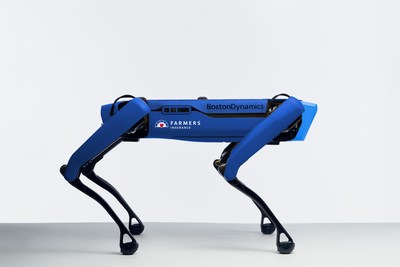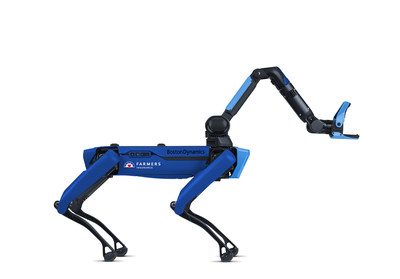Farmers Insurance will soon use a digitally controlled, four-legged mobile robot to assist with in-field catastrophe claims handling and non-catastrophe property inspections.
Plans call for debuting the robot – named Spot and with dexterous legs not unlike a dog’s – as early as this fall. Massachusetts-based Boston Dynamics developed Spot, which was customized for Farmers and will join the insurer’s claims personnel to help assess damage from catastrophes such as hurricanes, tornadoes, earthquakes and wildfires.

“Farmers’ focus on enhancing human-powered technology has led the organization to this very exciting milestone,” Samantha Santiago, head of Claims Strategy and Automation at Farmers, said in prepared remarks.
Farmers is one of the first national carriers to use a robot with four feet, the insurer noted, and it wants to use the cutting-edge device to help improve the safety and efficiency of the claims and property inspection processes.
Boston Dynamics, an engineering and robotics design company, spun out of the Massachusetts Institute of Technology in the early 1990s. Boston Dynamics’ cutting-edge work recently drew the attention of CBS news program “60 Minutes,” which profiled the company earlier in 2021.

Santiago said that adding “such a dynamic robot” to its collection of drones, satellite imagery and other technology helps the company build on its legacy and boost its customer commitments. In recent years, Farmers introduced an aerial imagery program leveraging drones, manned aircraft and satellite technology to help enhance claims operational efficiencies. Farmers also announced in late 2017 a virtual reality (VR) program to help train claims representatives for home damage assessments. The VR program is still being used today and has helped to train claims adjusters during the ongoing COVID-19 pandemic, Farmers said.
Spot’s agility, advanced mobility and perception to navigate various rough terrain are designed to help it to access spaces and environments inaccessible for claims employees. Spot will be equipped with a variety of sensors and cameras, including a 360-degree camera and site documentation software to help reduce the time required to capture data and augment the in-field claims review process, Farmers explained.
According to Farmers, Spot may also help claims adjusters collect critical data and assist with claims handling optimization to serve impacted customers more efficiently. Additionally, the robot may be put to work handling non-catastrophic events such as structure fires, collapsed structures, water loss or other potentially hazardous environments in the future.
In addition, Farmers will explore applications for Spot that could help first-responder organizations during scenarios such as post-event search and rescue operations, accessing areas to assess danger for first responders or others, and/or pre-inspections to assess safety for anyone in the general vicinity.
Source: Farmers





















 Slideshow: Carrier Management’s 2025 Top Editor’s Picks (Unlocked)
Slideshow: Carrier Management’s 2025 Top Editor’s Picks (Unlocked)  Breaking: Andersen to Replace Zaffino as CEO of AIG on June 1
Breaking: Andersen to Replace Zaffino as CEO of AIG on June 1  Is the AI Boom a Bubble Waiting to Pop? Here’s What History Says
Is the AI Boom a Bubble Waiting to Pop? Here’s What History Says  What to Expect in 2026: U.S. P/C Results More Like 2024
What to Expect in 2026: U.S. P/C Results More Like 2024 






